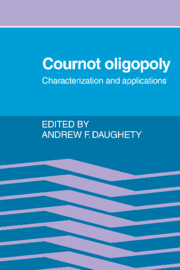Book contents
- Frontmatter
- Contents
- Preface
- Part I Introduction
- Part II Background
- Part III Examining Cournot's model
- Part IV Applications
- 12 Cournot and Walras equilibrium
- 13 Duopoly information equilibrium: Cournot and Bertrand
- 14 Information transmission – Cournot and Bertrand equilibria
- 15 Uncertainty resolution, private information aggregation, and the Cournot competitive limit
- 16 Losses from horizontal merger: the effects of an exogenous change in industry structure on Cournot–Nash equilibrium
- 17 Delegation and the theory of the firm
- 18 A study of cartel stability: the Joint Executive Committee, 1880–1886
18 - A study of cartel stability: the Joint Executive Committee, 1880–1886
Published online by Cambridge University Press: 07 September 2009
- Frontmatter
- Contents
- Preface
- Part I Introduction
- Part II Background
- Part III Examining Cournot's model
- Part IV Applications
- 12 Cournot and Walras equilibrium
- 13 Duopoly information equilibrium: Cournot and Bertrand
- 14 Information transmission – Cournot and Bertrand equilibria
- 15 Uncertainty resolution, private information aggregation, and the Cournot competitive limit
- 16 Losses from horizontal merger: the effects of an exogenous change in industry structure on Cournot–Nash equilibrium
- 17 Delegation and the theory of the firm
- 18 A study of cartel stability: the Joint Executive Committee, 1880–1886
Summary
This article employs weekly time series data on the Joint Executive Committee railroad cartel from 1880 to 1886 to test empirically the proposition that observed prices reflected switches from collusive to noncooperative behavior. An equilibrium model of dynamic oligopoly with asymmetric firms, together with explicit functional form assumptions about costs and demand, determines the estimating equations and stochastic structure of the econometric model. The hypothesis that no switch took place, so that price and quantity movements were solely attributable to exogenous shifts in the demand and cost functions, is then tested against this alternative and rejected.
Introduction
Industrial organization economists have recognized for some time that the problem of distinguishing empirically between collusive and noncooperative behavior, in the absence of a “smoking gun,” is a difficult one. This article exploits the model proposed in Green and Porter (1984). They consider an explicitly dynamic model in which the firms of an industry are faced with the problem of detecting and deterring cheating on an agreement. In particular, they assume that firms set their own production level and observe the market price, but do not know the quantity produced by any other firm. Firms' output is assumed to be of homogeneous quality, so they face a common market price. If the market demand curve has a stochastic component, an unexpectedly low price may signal either deviations from collusive output levels or a “downward” demand shock.
- Type
- Chapter
- Information
- Cournot OligopolyCharacterization and Applications, pp. 402 - 420Publisher: Cambridge University PressPrint publication year: 1989
- 1
- Cited by



